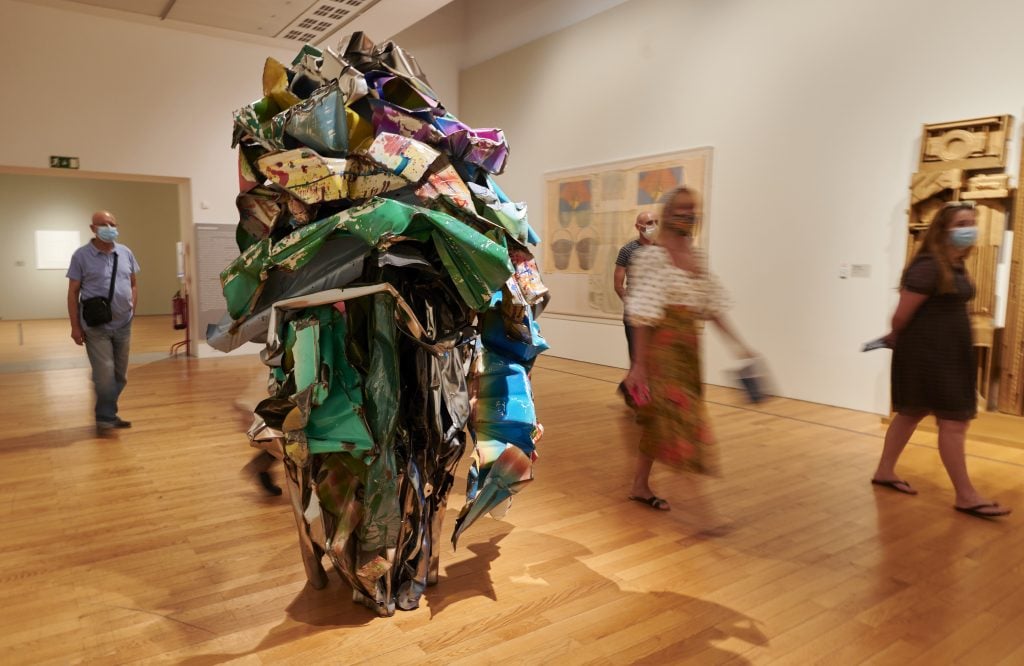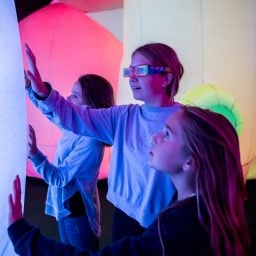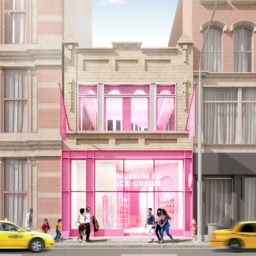The pandemic is likely to change the way people do just about everything—the way they travel, the way they shop, the way they work.
But for around 60 percent of respondents to a new Artnet News survey, it will have little impact on the way they interact with art.
This is one of the surprising takeaways from the survey, which polled almost 2,000 Artnet News readers from 67 countries (though the majority of respondents hailed from the US). All told, the survey paints a picture of an art-engaged audience concerned with safety, but also committed to in-person experiences with art—though maybe not for the reasons you might expect.
Here are the six biggest takeaways from our study.
1. The majority of respondents don’t plan to change their art-going behavior.
Approximately 60 percent of respondents say they anticipate no change in how often they visit museums and galleries once they reopen. (The majority of respondents noted that in the Before Times, they visited these venues multiple times per year.)
Notably, this trend holds constant for respondents over the age of 65—a group at higher risk of complications due to COVID-19.
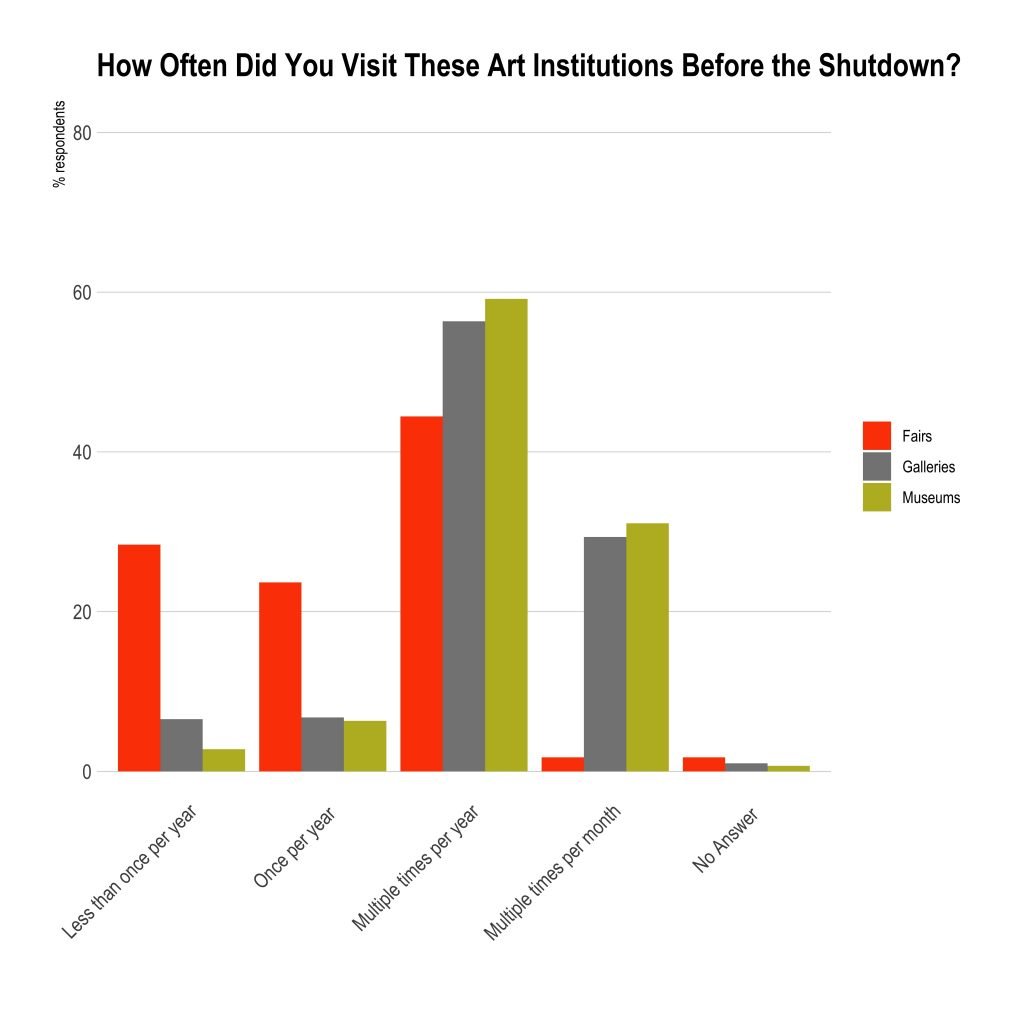
Graph by Taylor Whitten Brown.
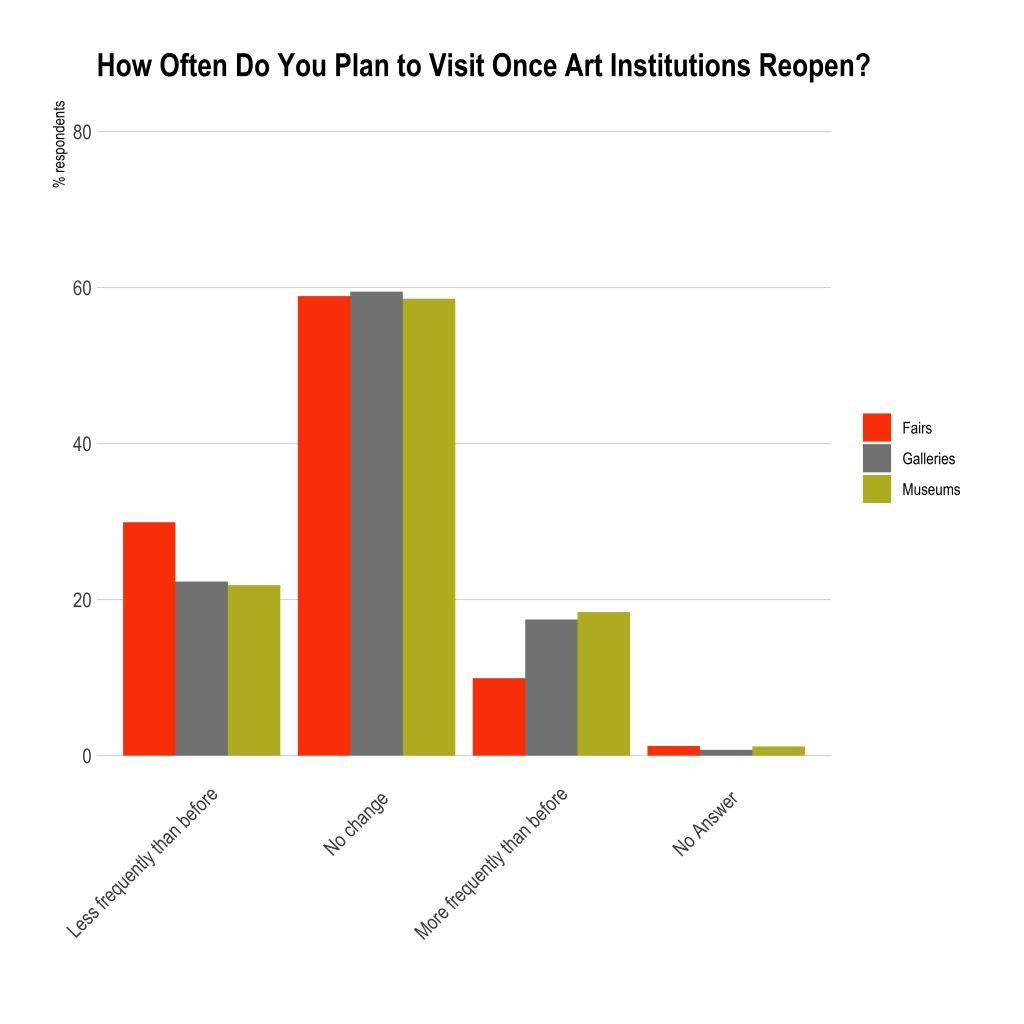
2. Art fairs will be the hardest hit.
The cultural space most affected by COVID-19 is indisputably the art fair.
Dozens of these events (which generate, on average, 50 percent of galleries’ annual revenue, according to the Art Basel UBS market report) have been cancelled this year. They are also the least easily adaptable to the social-distancing era, since they usually involve extensive travel, spending hours indoors wandering in and out of small booths, having close conversations, and rubbing shoulders (literally) with thousands of other guests.
It makes sense, then, that respondents to our survey list fairs as the art venue to which they are least likely to return quickly. Just over 30 percent of respondents say they anticipate visiting these commercial events less frequently in the future than they did before the shutdown (though it is unclear whether their response is driven by health concerns or the expectation that fewer fairs will be held in the coming months).
Notably, the plan to cut back on fair attendance is even more common among respondents who identify as art collectors: 37 percent of them say they plan to attend the events less often moving forward. (For comparison, just 22 percent of all respondents say they anticipate visiting museums and galleries less frequently.)
3. Audiences are most passionate about returning to museums first.
Galleries may be the least crowded venue in which to see art, and art fairs may have the most professional utility, but museums are far and away the cultural space respondents are most likely to return to first after the shutdown.
Fifty-nine percent of those surveyed say they plan to visit museums before any other art venue. (For comparison, 28 percent chose galleries—which, notably, opened before museums did in most cities; just 8 percent chose art fairs.)
This trend holds steady across age brackets: almost 60 percent of those both under and over the age of 65 chose museums. Those who identified as art collectors are slightly more likely to return to art galleries first than other respondents (almost 40 percent say galleries would be their first stop, but museums still win out among this group, too).
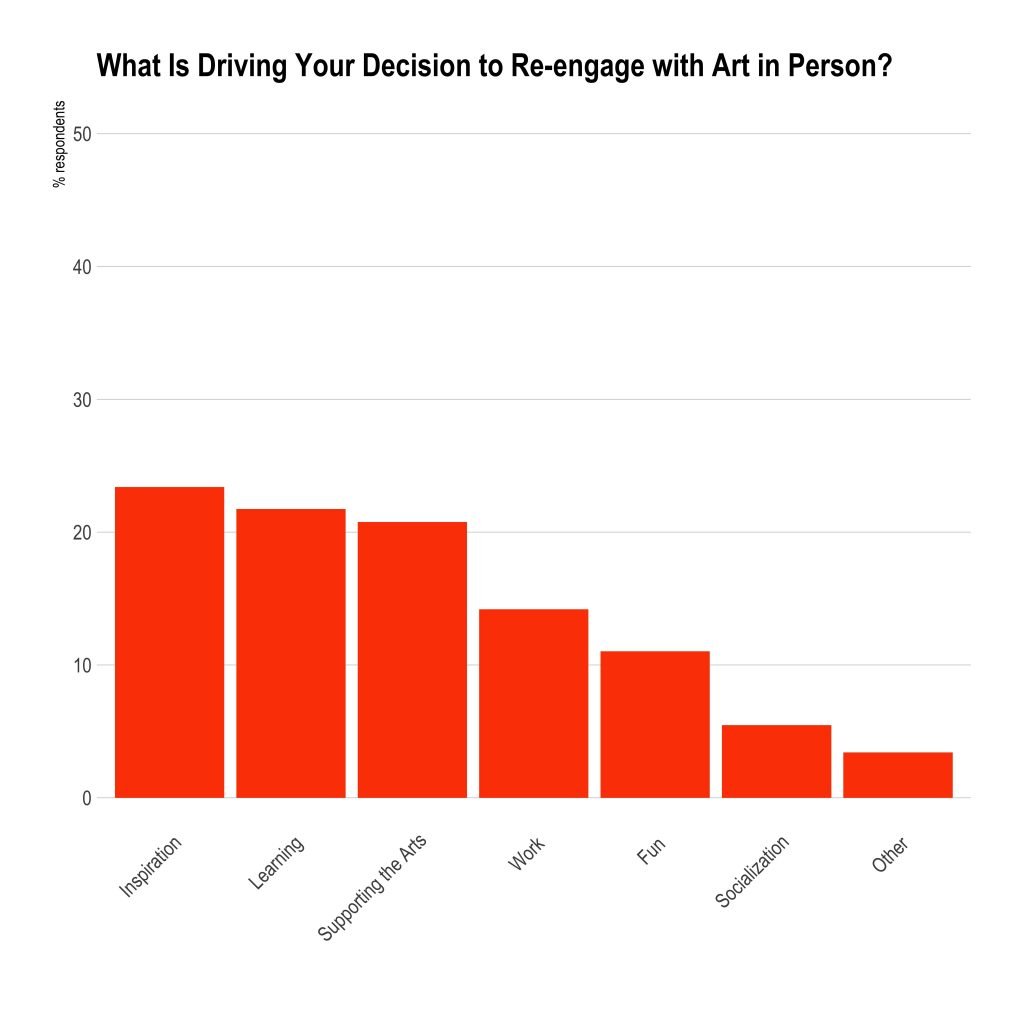
4. People aren’t as motivated to return to art venues to socialize or have fun.
A 2017 survey conducted by Culture Track found that having fun was the number-one reason for attending an arts activity. The survey’s release corresponded with the rise of Instagram-friendly “museums” like the Museum of Ice Cream, which offered photo ops and experiences that fulfilled a desire for cultural venues to serve as social, lighthearted gathering spaces.
But it appears that relationship may change in a post-COVID landscape. Asked what would drive a decision to re-engage with the arts in person, the most common answer among respondents (23 percent) is a desire for inspiration. (Learning and supporting the arts are the two other most popular answers; for visitors under 65, the need to attend for work is also cited as a common driver.)
On the other end of the spectrum, the least popular motivations for returning to arts venues are to socialize and to have fun. These factors—which were quite prominent in the Museum of Ice Cream era, though the audience of our survey may differ from Culture Track’s—could be less relevant for visitors now that socializing is safer to do outdoors than indoors. Plus, waiting in line to enter a crowd-controlled museum with a mask on may not be everyone’s idea of a freewheeling good time.
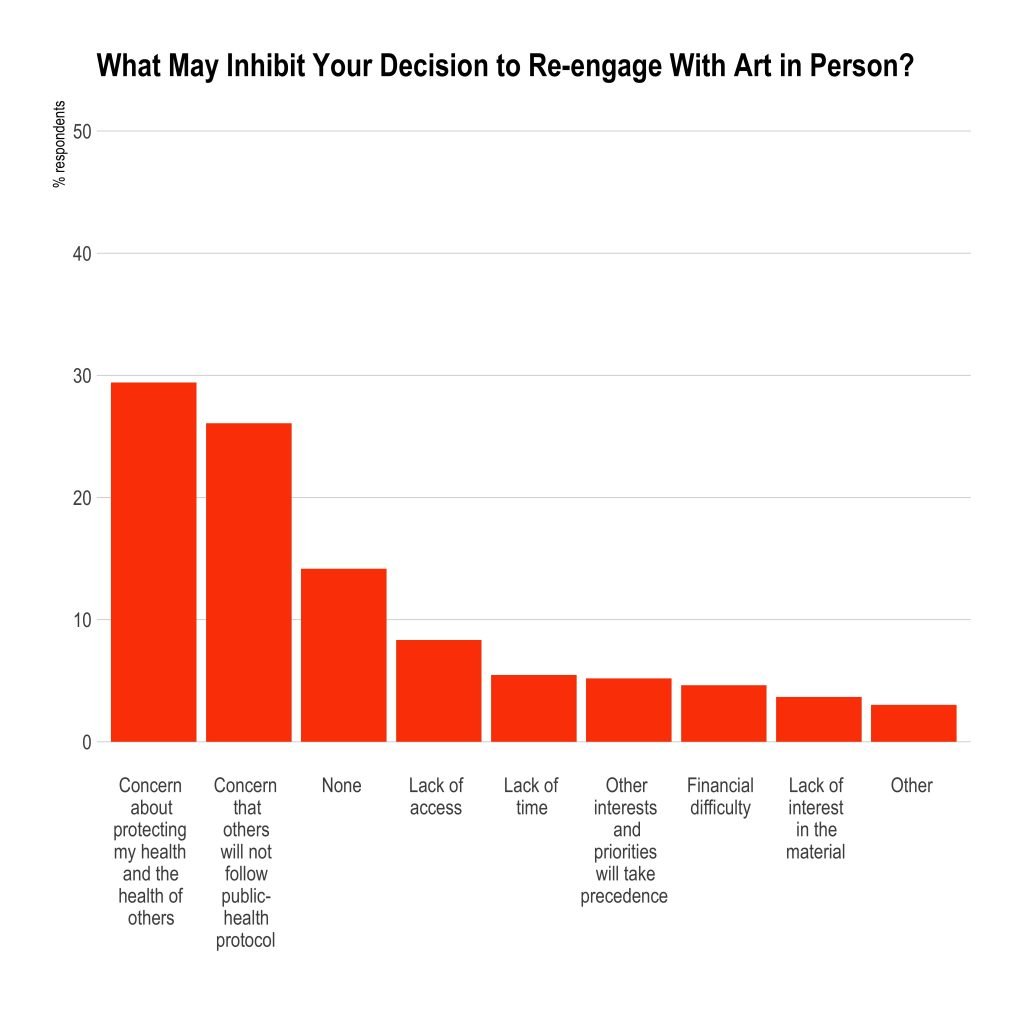
5. Safety measures are desirable and necessary—up to a point.
Perhaps unsurprisingly, the two leading factors inhibiting people’s decision to re-engage with art come down to safety: first, concern about protecting their own health and the health of others; second, concern that others will not follow public-health protocol.
The majority of respondents across all age brackets (67 percent) say they would be more likely to visit a museum if the use of masks were required (including those who anticipate visiting less frequently in the future). A similar proportion of respondents (69 percent) say that the ability to maintain a six-foot social distance is either a “very important” or an “extremely important” factor in their decision to return to a museum, gallery, or art fair within the next six months.
(Notably, there is a small group of people—around 9 percent—who are unconcerned with safety measures, stating that it is not important to maintain social distance and that mask-wearing would not impact their decision to visit a museum.)
Nevertheless, the twin desires to re-engage with art while ensuring safety only take visitors so far. Most respondents (53 percent) say they would pay a little more than the normal admission fee to access a museum at a lower capacity and ensure social distance, but fewer than seven percent say they would pay significantly more.
6. Special exhibitions may bring people back first.
Those who plan to return to museums may not do so to be around just any old work of art.
Forty-three percent of respondents say they are more likely to visit a special exhibition than the permanent collection galleries when they return to art museums. (Around 36 percent have no preference; just seven percent prefer the permanent collection.)
This is notable in part because it is consistent with visitors’ reported desire to seek art activities for inspiration and learning—seeing something new, as they would in a temporary exhibition, satisfies both needs in a culture-starved public.
Methodology: This article is based on a survey of Artnet News readers. We received 1,881 responses. Of these, 55 were from the United States; 65.5 percent were over the age of 54; almost 27 percent identified as artists, 14 percent as collectors, and 59 percent had other relationships to the art world.
